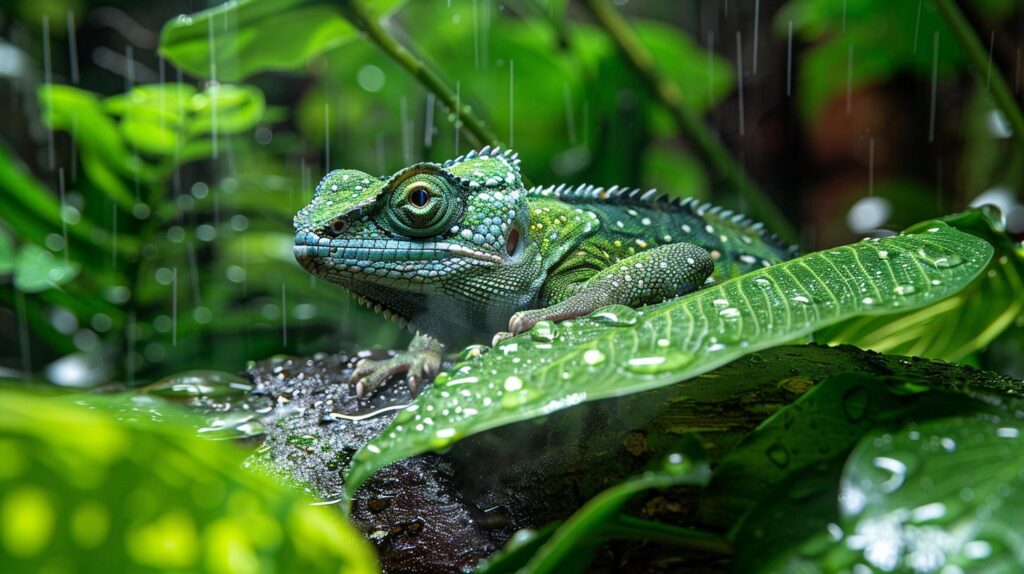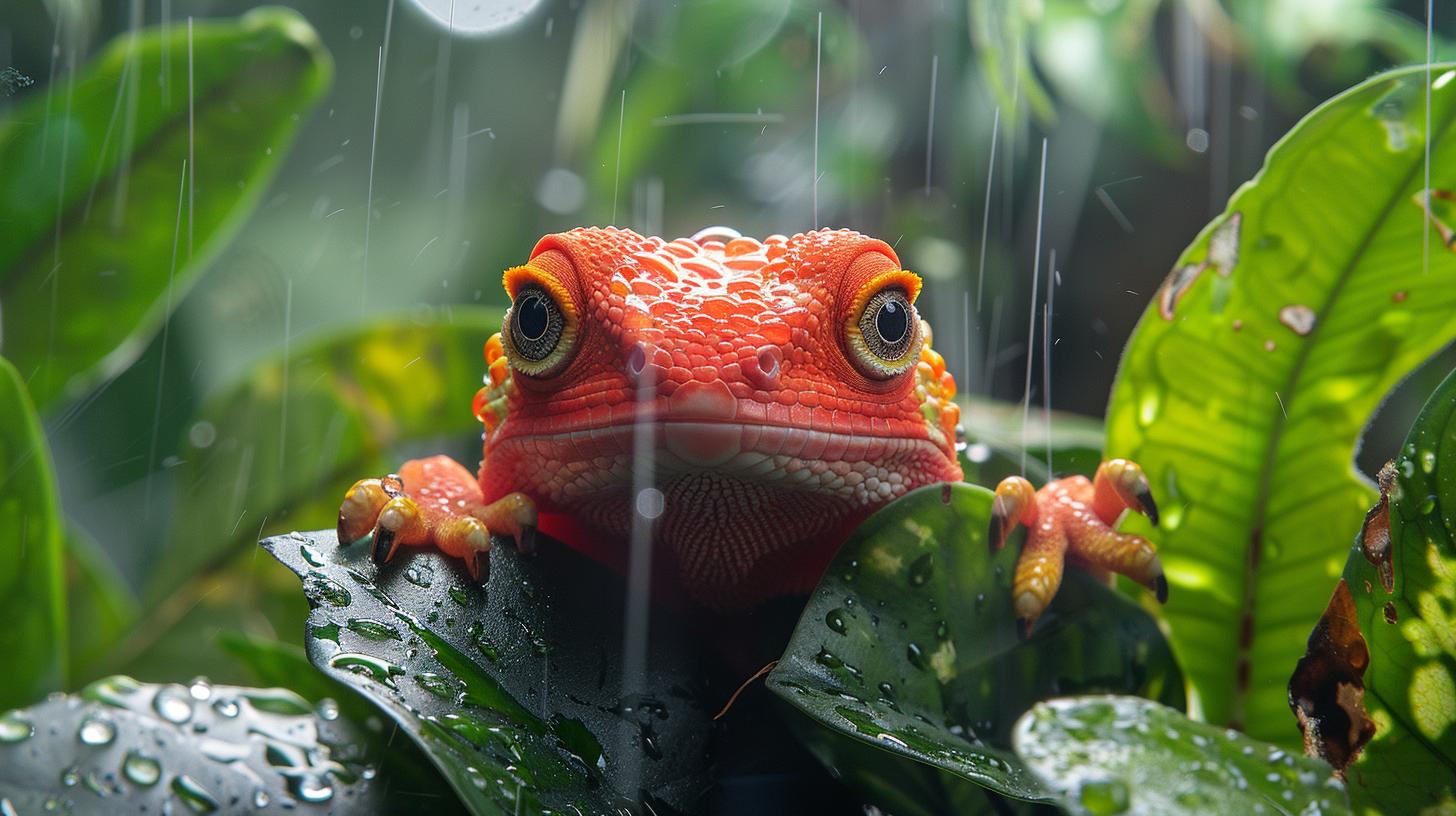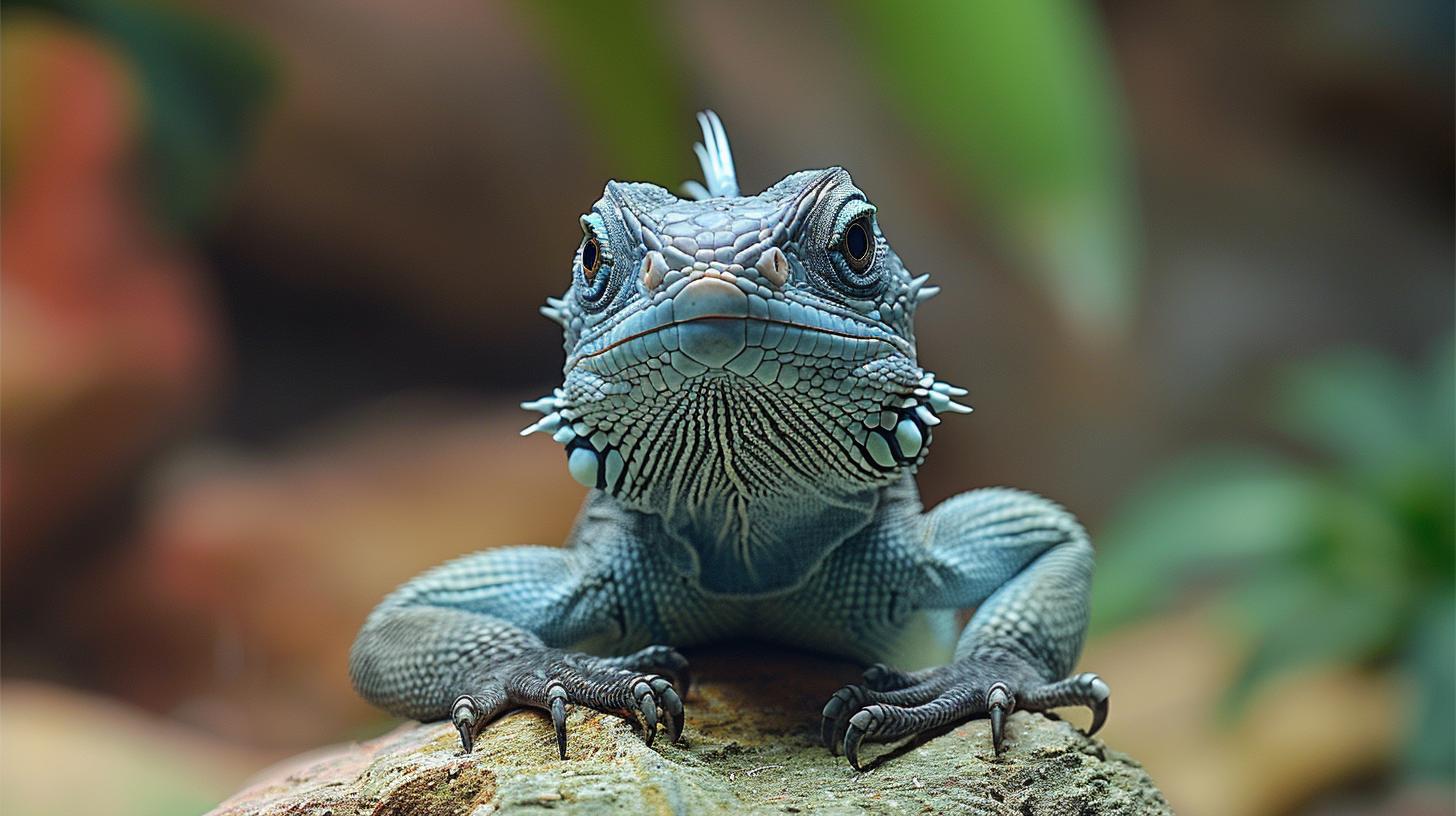Ideal Humidity Levels for Healthy Terrarium Reptiles: 3 Tips

Introduction to Reptile Care and the Role of Humidity
Understanding the ideal humidity for terrarium reptiles is pivotal for anyone delving into the world of reptile care. Terrarium dwellers come from a wide array of natural habitats, each with unique climatic conditions essential for their survival.
From the arid deserts to the lush tropical forests, these environments play a crucial role in the health and wellbeing of reptiles kept in captivity. Hence, replicating these conditions, especially humidity levels, within a terrarium isn't just beneficial-it's necessary.
Humidity-the amount of water vapor in the air-is more than just a number on a hygrometer; it's a lifeline for terrarium inhabitants. Proper humidity levels help maintain healthy skin, facilitate proper respiratory function, and support natural behaviors among reptile pets.
Whether it's shedding skin with ease or breathing without distress, the ambient moisture level within their enclosure has direct implications on their overall health. Therefore, understanding and controlling this environmental variable becomes a fundamental aspect of responsible reptile care.
The quest to mimic natural habitats leads us to recognize that not all terrarium residents have the same humidity needs For instance, Bearded Dragons thrive in relatively low humidity settings reminiscent of their arid homes, whereas Green Iguanas require much higher humidity levels to mirror the tropical climates they originate from.
Understanding these specific requirements is paramount in fostering an environment where your reptile can thrive optimally. Through thoughtful monitoring and adjustment of humidity levels within their enclosures, pet owners can significantly influence the comfort and longevity of their scaly companions.
Understanding Humidity and Its Importance in Terrariums
Humidity, the amount of water vapor present in the air, plays an integral role in the health and well-being of terrarium reptiles. Different species have evolved in diverse habitats ranging from arid deserts to lush rainforests, each with its unique humidity levels.
Consequently, maintaining species-specific humidity for terrarium reptiles is crucial for replicating their natural environments and promoting their physiological wellbeing. For instance, while a bearded dragon might thrive in lower humidity levels typical of arid landscapes, a green iguana requires a more moist environment to stay healthy.
The impact of humidity on reptiles extends beyond simple comfort; it affects their skin health, respiratory function, and even their behavior. Proper humidity levels help prevent issues like dysecdysis (difficult or incomplete shedding), which is common among reptiles living in environments not suited to their needs.
Additionally, correct humidity supports respiratory health by preventing desiccation and helps maintain mucous membranes that defend against infections. Moreover, certain behaviors such as burrowing or basking can be directly influenced by the terrarium's microclimate settings.
To effectively manage humidity for terrarium reptiles, enthusiasts must adopt several strategies:
- Regular Monitoring: Use hygrometers to consistently monitor the humidity levels within your terrarium. Digital models often provide more accuracy and convenience.
The Diverse Humidity Needs of Popular Terrarium Reptiles
Reptile enthusiasts understand that creating a thriving terrarium goes beyond setting up a tank and selecting a reptile. The diversity of reptiles that can be housed in terrariums - each originating from unique habitats around the globe - necessitates an understanding of varying environmental needs, particularly humidity.
Some species flourish in dry, arid conditions, reminiscent of deserts, while others require moist, rainforest-like environments to thrive. Recognizing and meeting these distinct humidity requirements is fundamental to ensuring the health, well-being, and longevity of terrarium reptiles.
Humidity for terrarium reptiles plays a pivotal role that cannot be overstated. It affects everything from skin health and shedding processes to hydration and respiratory function. A mismatch between a reptile's natural humidity requirement and its terrarium environment can lead to stress, disease, and even premature death. Therefore, gaining insights into the specific humidity needs of popular terrarium dwellers becomes a critical aspect of successful reptile care.
Understanding Specific Humidity Requirements
The quest to replicate a natural habitat within the confines of a terrarium starts with identifying the specific humidity needs of each reptile species. For instance, Bearded Dragons, hailing from the arid landscapes of Australia, thrive in relatively low humidity levels ranging from 20% to 40%.
On the other end of the spectrum are Green Iguanas, native to rainforests in Central and South America, which require a more tropical atmosphere with humidity levels consistently between 65% to 75%. This stark difference underscores why generalized approaches to humidity control can be detrimental to reptile health.
Tailoring Humidity for Healthy Terrarium Habitats
Adapting your terrarium's environment to fit these diverse needs begins with precise measurement tools like digital hygrometers; reliable devices capable of monitoring real-time humidity levels within the enclosure. Beyond simply measuring is the practice of adjusting conditions through methods such as misting systems for higher humidity requirements or ventilated enclosures for drier atmospheres. These approaches showcase how tailored interventions can create optimal conditions for each species.
The Significance of Research and Monitoring
Knowledge becomes power when it comes to managing humidity for terrarium reptiles. Thorough research on the preferred living conditions for your specific pet ensures informed decisions can be made from setup onwards. Additionally, regular monitoring helps catch any deviations early on before they escalate into significant health issues-proving that consistent oversight forms the backbone of effective humidity management in reptile care.
By acknowledging and responding appropriately to these diverse needs and preferences across popular terrarium species-from Bearded Dragons' preference for dryness to Green Iguanas' need for constant moisture-reptile caregivers can curate environments where their pets not only survive but flourish.

Three Essential Tips for Managing Humidity for Terrarium Reptiles
Maintaining the *humidity for terrarium reptiles* is not just about providing a comfortable environment-it's about creating conditions that are vital for their health and well-being. Each species has its unique humidity requirements, making it necessary to understand and implement specific techniques that ensure these needs are met consistently. Here, we delve into three essential tips that can help reptile owners manage humidity levels effectively within their terrariums.
Firstly, investing in a reliable hygrometer is indispensable for anyone looking to maintain optimal humidity levels in a reptile's habitat. A hygrometer measures the amount of moisture in the air, allowing owners to monitor the environment closely and adjust accordingly.
Given that different species require varied humidity levels, keeping an eye on these readings will enable one to provide the ideal conditions specific to their pet's natural habitat. For instance, while Bearded Dragons thrive in relatively dry conditions with humidity levels around 30-40%, tropical species like Green Iguanas prefer more moist environments with humidity levels ranging from 50% to 70%.
| Reptile Species | Ideal Humidity Range (%) |
|---|---|
| Bearded Dragons | 30-40% |
| Green Iguanas | 50-70% |
Secondly, effective ventilation cannot be overstated when managing *humidity for terrarium reptiles*. Proper airflow prevents the buildup of excess moisture which can lead to mold growth and respiratory issues in reptiles. By ensuring there is enough ventilation within the terrarium, you create a dynamic environment where fresh air circulates properly, balancing out humidity levels naturally. However, it's crucial to strike a balance as too much ventilation might lower humidity below what your reptile requires.
Lastly, incorporating live plants can significantly improve regulation of humidity within a terrarium. Plants naturally transpire, releasing water vapor into the air which increases humidity levels. Not only do they help in maintaining consistent moisture content in the air but also purify it by absorbing toxins. Choosing plants that align with your pet's natural ecosystem will further enhance their habitat's resemblance to their original home-promoting better overall health and emotional well-being.
Implementing these tips will go a long way in achieving and sustaining the required *humidity for terrarium reptiles*, ensuring they lead healthy lives within our care. Yet, beyond just focusing on equipment or structural setup, remembering that each species has its distinct needs is fundamental in this process. Continuously researching and adjusting your approach based on observations of your pet's health and behavior holds key significance as well.
As we progress into exploring advanced techniques for maintaining optimal humidity conditions.
Advanced Techniques for Maintaining Ideal Humidity
Reptile enthusiasts understand that creating an environment that closely mimics a reptile's natural habitat is crucial for its wellbeing. This is especially true when it comes to humidity for terrarium reptiles, a factor that can greatly influence their health and comfort.
Advanced techniques for maintaining ideal humidity not only make life easier for the reptile owner but also ensure that the reptiles live as they would in the wild, with all of their unique needs met meticulously. In this section, we will explore some sophisticated methods that go beyond just spraying water into the air and delve into how technology can be harnessed to keep humidity levels just right.
The journey towards achieving perfect humidity in a terrarium begins with understanding the specific needs of your reptile. While traditional methods like manual misting have their place, they often fall short in providing consistent and accurate humidity levels. This inconsistency can lead to stress and health issues for terrarium-dwelling reptiles. As such, stepping up our game with more advanced techniques becomes not just beneficial but somewhat necessary for those committed to providing the best care possible.
Automated Misting Systems
One of the most effective upgrades one can make in the realm of terrarium humidity control is investing in an automated misting system. These systems are designed to release fine mists of water into the terrarium at preset intervals, ensuring that the humidity levels remain stable throughout the day without constant manual intervention.
For species requiring high humidity levels, such as Green Iguanas, this level of control can be a game-changer. Automated misters also reduce the risk of over-misting which can lead to mold growth and other unwanted issues within a terrarium ecosystem.
Digital Hygrometers and Humidistats
To truly master humidity control, pairing an automated misting system with digital hygrometers or humidistats is essential. These devices measure and display real-time humidity levels within a terrarium, allowing owners to make precise adjustments as needed.
Some advanced models even connect directly to misting systems or humidifiers, turning them on or off automatically based on preset humidity ranges. This kind of targeted control ensures that every reptile enjoys its ideal living conditions without excessive guesswork or constant monitoring from the owner.
The Balance Between Technology and Natural Care
While technological solutions offer convenience and accuracy in maintaining ideal humidity for terrarium reptiles, it's important to remember they should complement rather than replace natural care practices. Regularly checking on your reptile's habitat personally, ensuring proper ventilation, and making adjustments based on seasonal changes are all practices that continue to play a significant role in effective humidifier management.
However, by integrating these advanced tools and techniques into your care routine, you significantly enhance your ability to create a consistently comfortable environment that allows your pet reptiles not just to survive but thrive.

Common Mistakes to Avoid in Humidity Management
Maintaining the right humidity for terrarium reptiles is vital, yet it's often overlooked or improperly managed by many reptile owners. This section sheds light on frequently made errors in humidity control and offers guidance on how to sidestep these pitfalls to foster a healthier environment for your terrarium residents.
One prevalent mistake is the over-reliance on inaccurate hygrometers. Many terrarium kits come with analog hygrometers, which can be notoriously unreliable. Investing in a digital hygrometer greatly improves the accuracy of humidity measurements, ensuring that you're providing an optimal environment for your pet. Digital hygrometers, while slightly more expensive, offer peace of mind that you're maintaining the ideal *humidity levels* needed by your reptile species.
Another common issue stems from misunderstanding the natural humidity needs of different reptile species. For instance, a Bearded Dragon requires significantly lower humidity levels compared to a Green Iguana. This lack of knowledge can lead to conditions that are either too dry or too moist, both of which can be harmful. To avoid this:
- Research extensively about your specific type of terrarium reptile.
- Regularly monitor and adjust the humidity within their habitat as required.
Adjustments might include adding water bowls or live plants to increase humidity or improving ventilation to decrease it. However, changes should be gradual to prevent shocking your pet's system.
Lastly, failing to respond promptly to signs of improper humidity levels can lead to long-term health issues for your reptile pets. Signs such as skin shedding problems, respiratory infections, or changes in behavior indicate that the terrarium's climate may not be properly regulated. It's important not only to observe these signs but also to act quickly by adjusting your habitat setup accordingly.
Continuously learning and adapting your approach will help avoid common mistakes in managing humidity for terrarium reptiles and contribute positively towards creating a thriving environment for them. As we further explore ways to maintain ideal conditions within our pets' habitats, let's remember that every small step towards better understanding and management is a leap towards their well-being.
Real-Life Success Stories
In closing, the journey through understanding and mastering humidity for terrarium reptiles culminates in an appreciation of its nuanced, yet profound influence on our reptilian companions' health and welfare. By navigating through the practical advice, detailed outlines of species-specific needs, and embracing the technology available for environmental management, enthusiasts are equipped to recreate a slice of the wild within their own homes.
This commitment to maintaining ideal conditions underscores the bond between caretakers and their pets, where every effort is made to ensure a thriving, vibrant life for these fascinating creatures.
The stories shared by fellow reptile aficionados serve as both inspiration and testament to what can be achieved with dedication and knowledge. They are not merely tales of success but are blueprints for fostering environments where our scaled friends can flourish. From understanding the importance of humidity in respiratory health to appreciating its role in skin shedding processes, it's clear that achieving perfect humidity for terrarium reptiles is more than a task-it's a labor of love.
We invite you to further enrich your care toolkit by delving into our extensive collection of articles dedicated to reptile wellness, habitat enrichment, and innovative care practices. Whether you're setting up your first terrarium or looking to refine your existing setup, our resources are designed to guide you every step of the way.
Dive into our library today and embark on your next adventure in reptile care excellence - because here, we believe every pet deserves a place where they can thrive just as they would in nature.
Frequently Asked Questions
How Do I Keep My Reptile Enclosure Humid?
Keeping your reptile enclosure humid involves regularly misting the habitat with water, using a substrate that retains moisture well, such as coconut fiber or sphagnum moss, and incorporating a humidifier or vaporizer designed for reptile use. It's also helpful to cover part of the tank's screen lid with plastic wrap to help retain moisture inside the enclosure.
What Is the Best Humidity for a Terrarium?
The best humidity for a terrarium largely depends on the specific needs of the plant or animal residing in it. Generally, tropical species thrive in environments with 70-90% humidity, while desert species require lower levels around 40-60%. Always research the humidity requirements for your specific species to create an optimal environment.
What Should the Humidity Be in a Snake Enclosure?
In a snake enclosure, humidity levels should typically range between 40% and 70%, varying according to the specific breed of snake. For example, tropical snakes usually need higher humidity closer to 70%, while desert snakes are better suited to conditions around 40%. Consistently meeting these requirements is crucial for their health and well-being.
How Humid Is Too Humid for a Bearded Dragon?
A bearded dragon’s habitat becomes excessively humid if it reaches levels above 40%. These reptiles are native to arid regions and thus thrive in low humidity environments. High humidity can lead to respiratory infections and other health issues in bearded dragons.
How Do I Know if My Terrarium Is Too Humid?
Signs that your terrarium is too humid include condensation on the walls that doesn’t go away after adjustments, mold growth on the substrate or decorations, and an overall musty smell emanating from within. If you encounter these signs, you'll need to reduce the humidity by improving ventilation or adjusting your watering schedule.
Why Is the Humidity in My Terrarium So High?
The humidity in your terrarium may be high due to overwatering plants, insufficient ventilation causing poor air circulation, or environmental factors outside of the terrarium such as living in a naturally humid climate. Addressing these factors by moderating water addition, improving airflow within the terrarium, and using dehumidifiers near the setup can help manage excessive moisture.
Leave a Reply
You must be logged in to post a comment.